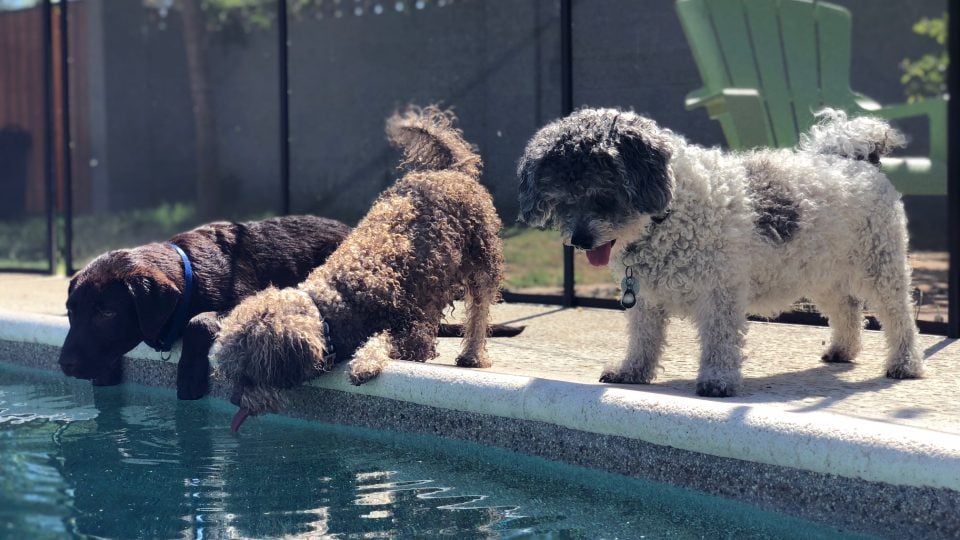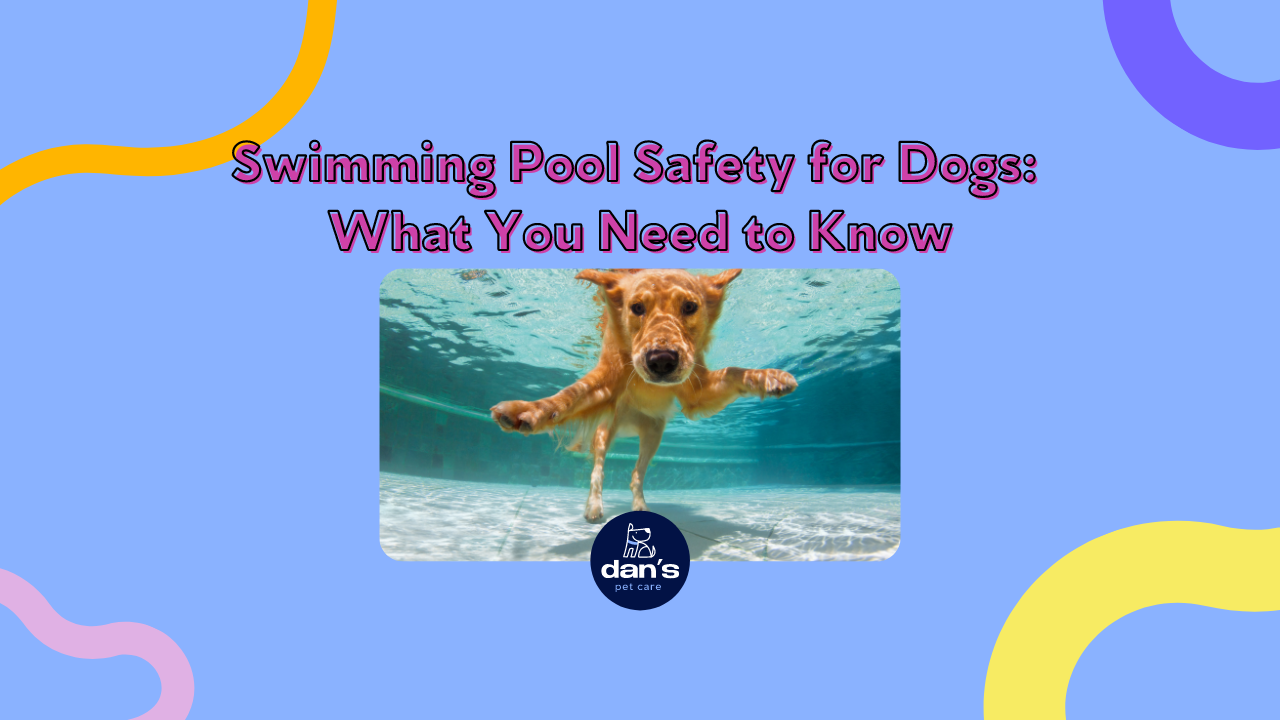Yes, it is safe for dogs to swim in pools with supervision, as long as the water is well-balanced and chlorinated or saltwater. However, dogs should not drink from the pool.
Now, let’s explore some important information about dogs and swimming pools. Swimming pools can provide a fun and refreshing activity for both humans and dogs. However, there are certain things owners need to be aware of to ensure their furry friends’ safety.
We will discuss the safety precautions, potential dangers, and maintenance tips related to dogs and swimming pools. So, if you’re considering allowing your dog to take a dip in the pool, keep reading to learn what you need to know.

Credit: reliefpools.com
Is It Safe For Dogs To Swim In Pools?
Swimming in a well-maintained pool is generally safe for dogs, as long as they are supervised and don’t drink the water. Whether it’s chlorinated or saltwater, swimming in pools can be an enjoyable activity for dogs. Just make sure to take necessary precautions and prevent any potential dangers.
Overall Safety Of Dogs Swimming In Pools
Is it safe for dogs to swim in pools? Well, the short answer is: Yes, with supervision, it is typically safe for a dog to swim in a well-balanced chlorinated or saltwater swimming pool. Of course, do not let your dog drink from the pool, but otherwise, yes, overall, it is safe.
Preventing Swimming Pool Pet Dangers
- Install a Pool Fence: Sometimes a fence blocks off a general part of the yard, keeping younger children and fur children away from the pool.
- Teach Your Dog to Swim: Introduce your dog to the water gradually and teach them how to enter and exit the pool safely.
- Use Dog Life Jackets: If your dog is not a strong swimmer or you have concerns about their safety, consider using a dog life jacket to provide extra buoyancy and peace of mind.
- Always Supervise Your Dog Around Water: Never leave your dog unattended in or near the pool. Even if they are strong swimmers, accidents can happen, and supervision is crucial to prevent any mishaps.
- Bathe Your Dog After Every Swimming Session: To prevent any skin irritation or reactions, it is recommended to bathe your dog after they have been in the pool.
It’s important to note that while swimming in a pool is generally safe for dogs, there are still some factors to consider. For example, dogs with certain health conditions may not be suitable candidates for swimming. Additionally, it’s crucial to pay attention to the pool’s water chemical levels to ensure they are within safe limits for your dog’s well-being.
By following these safety measures and guidelines, you can ensure a fun and safe swimming experience for your furry friend.

Credit: www.rover.com
Keeping Dogs Safe Around The Pool
Swimming pools can be safe for dogs as long as they are supervised and the pool is well-balanced with chlorine or saltwater. However, it is important to prevent dogs from drinking pool water. Additionally, installing a pool fence, teaching dogs to swim, and using life jackets can further ensure their safety around the pool.
Installing A Pool Fence
To ensure the safety of your furry friend around the pool, consider installing a pool fence. A pool fence creates a physical barrier that prevents dogs from accessing the pool area unsupervised. It is especially beneficial if you have younger children or energetic dogs who might be tempted to explore the pool without realizing the potential dangers. By installing a pool fence, you not only protect your dog but also provide peace of mind for yourself.
Teaching Dogs To Swim
Teaching your dog to swim is another crucial step in keeping them safe around the pool. Contrary to popular belief, not all dogs are natural swimmers. Some may need guidance and practice to feel comfortable in the water. Start by introducing your dog to shallow areas, encouraging them to paddle and gradually increasing the depth as they gain confidence. Make the experience positive and rewarding with treats and praise. Remember to always supervise your dog during swimming lessons and never force them if they show signs of distress.
Using Dog Life Jackets
Dog life jackets are essential safety accessories to consider when your dog is around the pool. Even if your dog is a strong swimmer, a life jacket provides an extra layer of protection, especially in case of accidents or exhaustion. Look for a well-fitting life jacket that allows for unrestricted movement and includes a grab handle for easy rescue if needed. Ensure the life jacket is properly secured on your dog before they enter the water.
Supervising Dogs Around Water
The most important aspect of keeping your dog safe around the pool is constant supervision. Never leave your dog unattended near the pool, as accidents can happen quickly and silently. Create a designated area where your dog can play and relax while you are nearby. Additionally, be cautious with swimming sessions in unfamiliar bodies of water such as lakes or rivers, as the conditions may be different from a controlled pool environment. Always stay alert and ready to jump in if necessary.
Sanitary Considerations For Dogs Swimming In Pools
Swimming pools can be safe for dogs, as long as they are supervised and the pool is well-balanced with chlorine or saltwater. However, dogs should not drink from the pool to maintain sanitary conditions.
Safety Of Dogs Swimming In Different Pool Systems (chlorine, Saltwater, Mineral)
It’s important to consider the safety of dogs swimming in different pool systems such as chlorine, saltwater, and mineral. Each type of pool system has its own benefits and considerations when it comes to your dog’s health and well-being.How Dogs Can Affect Pool Water
When dogs swim in pools, they can impact the cleanliness and quality of the pool water. Here are some factors to keep in mind:- Dogs may introduce dirt, debris, and hair into the pool, which can affect the water clarity.
- Dogs’ skin and fur can contain natural oils that can alter the chemical balance of the pool water.
- Dogs may urinate or defecate in the pool, which can introduce bacteria and affect the overall sanitation.
Ensuring Sanitary Pool Conditions For Dogs
To maintain a sanitary swimming environment for your dog, it’s essential to take certain precautions:- Regularly clean and skim the pool to remove any floating debris and hair.
- Monitor and maintain the proper chemical balance of the pool water, especially the chlorine or salt levels, to ensure it remains safe for your dog.
- Consider using dog-specific pool chemicals or treatments to help control bacteria and maintain a healthier swimming environment for your pet.
- Encourage your dog to take regular breaks outside the pool to minimize the risk of accidents or contamination.
- After swimming, rinse your dog thoroughly with clean water to remove any chlorine, salt, or pool chemicals that may be left on their fur or skin.
- Regularly bathe your dog to keep their skin and fur clean and free from any potential irritants.
Skin And Health Concerns For Dogs In Pools
It is generally safe for dogs to swim in a well-maintained pool with supervision. However, it is important to prevent them from drinking the pool water to avoid any health concerns. Take the necessary precautions and enjoy swimming with your furry friend.
Potential Redness Or Skin Irritation
When a dog goes in a pool, redness or skin irritation can occur. The chemicals in the water may react with the dog’s skin, especially if they stay in the water for extended periods. It’s important to keep an eye out for any signs of redness or irritation on your dog’s skin. If you notice any changes, it’s best to take your pet to the vet for a check-up. Additionally, after every swimming session, make sure to bathe your dog to remove any residual chemicals that may cause further irritation. Taking these precautions will help protect your dog’s skin health.Taking Necessary Precautions For Dogs’ Skin Health
To ensure your dog’s skin stays healthy and irritation-free while swimming in a pool, there are a few precautions you can take. Firstly, consider using a dog-friendly shampoo or conditioner designed specifically for swimming to help neutralize any chemical residue. Additionally, provide your dog with regular coat care, such as brushing, to remove any debris or chemicals that may have clung to their fur during swimming. Moreover, keeping the pool clean and well-maintained helps minimize the risk of skin issues for your furry friend. Regularly check and balance the pool’s chlorine or salt levels to ensure they’re at appropriate levels for your dog’s safety. Lastly, remember to supervise your dog while they’re in the pool and discourage them from drinking the pool water. By following these precautions, you can help maintain your dog’s skin health while enjoying pool time together.Tips For Pool Safety And Preventing Pool Dangers For Dogs
Ensure your furry friend’s safety around the pool with these tips: Install a pool fence, teach your dog to swim, use dog life jackets, and always supervise your dog around water. It’s generally safe for dogs to swim in a well-maintained pool, but prevent them from drinking the water.
Properly maintaining the swimming pool: Ensuring the safety of your furry friend starts with properly maintaining your swimming pool. This not only keeps the water clean and inviting but also reduces the risk of any potential hazards. Here’s what you need to know: 1. Regular water testing: One crucial aspect of maintaining a safe swimming environment for your dog is regular water testing. This ensures that the pool’s pH levels are balanced and the chlorine or salt levels are within the safe range. Testing the water at least once a week helps to prevent any potential skin irritation or allergic reactions for your dog. Remember, a dog’s skin can be sensitive to chemicals, so keeping the water well-balanced is essential. 2. Ensuring a properly functioning pool: A properly functioning pool is key to promoting the safety of your dog. Regularly inspect all pool equipment, including filters, pumps, and drains, to ensure they are in optimal condition. Check for any signs of wear and tear or malfunctioning parts that could pose a risk to your pet. Taking proactive steps to maintain your pool’s infrastructure will provide a worry-free swimming experience for your furry friend. Promoting cleanliness and hygiene in and around the pool area: Maintaining cleanliness and hygiene in and around the pool area is crucial for ensuring your dog’s safety. Here’s what you need to keep in mind: 1. Promote regular hygiene: Dogs love to explore, roll around, and play in the dirt, so it’s essential to rinse them off before they enter the pool. This simple step helps to keep the pool water free from excess dirt, debris, and contaminants that your dog might carry on their fur. 2. Provide shaded areas: Just like humans, dogs can also get overheated in the sun. Make sure to provide shaded areas around the pool for your furry friend to relax and cool down when needed. This protects them from heat exhaustion and ensures their overall safety and well-being. To summarize, adhering to these tips for pool safety and preventing pool dangers for dogs will provide a safe and enjoyable swimming experience for your furry friend. By properly maintaining the swimming pool, conducting regular water testing, ensuring a properly functioning pool, and promoting cleanliness and hygiene, you can create a worry-free environment for your dog to splash and play in. Remember, a happy and safe dog is a dog who can thoroughly enjoy their time in the pool!:strip_icc()/GettyImages-153945454-5a18a4d4b39d030039080cf3.jpg)
Credit: www.thesprucepets.com
Frequently Asked Questions Of Dogs And The Pool: What You Need To Know
Is It Safe For Dogs To Be In Pools?
Yes, with supervision, it is typically safe for dogs to swim in a well-balanced chlorinated or saltwater pool. Avoid letting them drink from the pool. Overall, it is safe. Prevent potential dangers by installing a pool fence and using dog life jackets, and always supervise your dog around water.
How Do I Keep My Dog Safe Around The Pool?
It is safe for dogs to swim in a well-balanced chlorinated or saltwater swimming pool with supervision. However, do not let your dog drink from the pool. To keep your dog safe around the pool, install a pool fence, teach them to swim, use dog life jackets, and always supervise them around water.
Is It Sanitary For Dogs To Swim In Pool?
Yes, it is sanitary for dogs to swim in pools. Supervised swimming in well-balanced chlorinated or saltwater pools is typically safe. Just make sure your dog doesn’t drink from the pool. Many pool owners swim with their dogs without issues.
What Happens When A Dog Goes In A Pool?
Yes, it is safe for dogs to swim in a properly balanced chlorinated or saltwater pool with supervision. Avoid letting them drink the pool water and bathe them after swimming to prevent any skin irritation.
Conclusion
Swimming pools can be a fun and refreshing activity for dogs, but it’s essential to take certain precautions. Remember to supervise your dog while they swim, prevent them from drinking pool water, and implement safety measures like pool fences and life jackets.
Whether your pool uses chlorine or saltwater, it is generally safe for dogs as long as the water is well maintained. By following these guidelines, you can ensure a safe and enjoyable pool experience for your furry friend.

